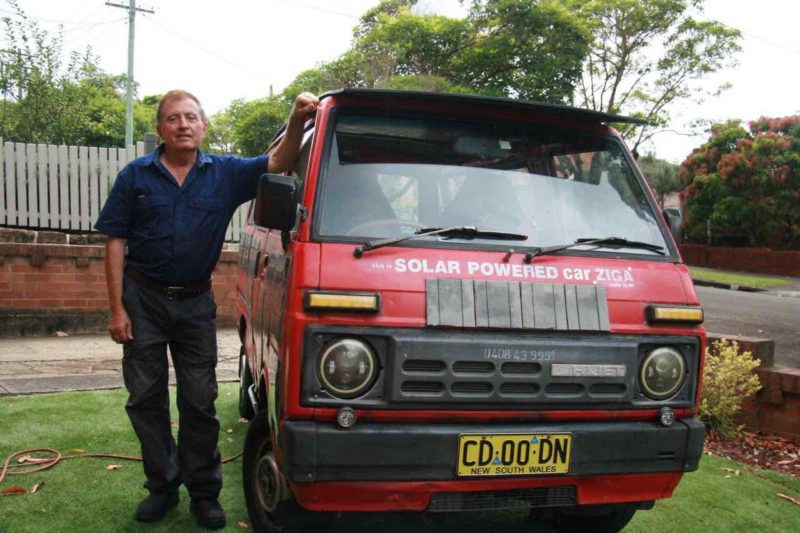It’s the sound you notice first. Cutting through the hum of car engines, an electric whirr signals something different is on the way. As the small red van zips past, the solar panels covering the roof and sides show this is something very different – and the story behind it is remarkable too.
Seven years ago Ziga Dorkic, industrial engineer, inventor and lifelong specialist in designing and making things, decided the best way to show how simple it could be to have a budget-friendly solar-powered electric car was to make one. His van is the result.
Ziga’s machine is a showcase of reuse, recycling and emissions-free energy. Its electric motors come from old ride-on lawnmowers, while power comes from solar panels and is stored in 7,000 – yes, seven thousand – batteries recovered from old laptops and power tools.
The result is a daily driver that takes Ziga on errands around his neighbourhood in Sydney’s inner west and on trips to the outer western suburbs, all without a cent spent on fuel.
People’s first reaction to the vehicle with its eye-catching covering of 24 solar panels is almost always the same.
“Every time I go shopping there’s always someone coming up to me and saying ‘is this real?’,” Ziga says.
“I say ‘bloody hell, it’s real alright!’”
Years before building the van, Ziga had taught a course at Meadowbank TAFE that involved building an electric car for students.
“I thought, I did this for other people, why don’t I do it for myself?”

He found a second-hand Daihatsu Hijet van – “a perfect car with a lot of surface area” and got to work in his home workshop. Built in the 1980s, the Hijet was a mini workhorse with a tiny petrol engine. Millions of the little vans have been sold around the world but the one roving the streets of Sydney is unique.
The petrol engine was replaced by three motors from electric ride-on lawnmowers. They connect to the original gearbox via a drivetrain Ziga designed himself. Then with a spot welder – also home-made – he connected up the 7,000 batteries to create power banks that line the floor and sit in a suitcase-sized unit in the van’s load bay.
The battery in a factory-built electric car such as a Tesla uses the same concept – thousands of small lithium ion batteries, each a bit bigger than a regular AA battery, are connected together to make a big bank.
All the power comes comes from the sun: when it’s not in use the van is hooked up to a large solar array on the roof of Ziga’s house. The solar panels on the van provide power to indicators and top up the batteries on the go but the main charge comes from the rooftop array. That setup, built by Ziga, powers not only the van but also his house via a large battery bank.

Ziga still hasn’t found the limits of the van’s power reserves: his longest trip so far has been a 100km return run to south-western Sydney and he got home with enough charge left to do it all again.
“I didn’t even come close to half,” he says.
Whatever the range, it’s about to get bigger again as Ziga’s current project is adding another 2,000 cell power bank to the van.
The engineering skills that Ziga puts into his van were honed over decades working around Sydney’s inner-west in the days when it was a hub of manufacturing and innovation – buzzwords today that were simple daily realities of Australian business 40 years ago.
Ziga came to Australia from his native Croatia at the age of 21, the son of a wheelwright and educated as an industrial engineer. He studied English in classes held at Fort St High School and worked in factories before setting up to work on his own: the inner west in the 1970s had an industrial core where Ziga’s skills were in demand.
“Leichhardt was full of factories, there was a shoe factory, a screw factory, a paper mill. I would knock on the door and say ‘I’m an engineer – I can do whatever you want’,” he says.
He built up a client base of factories who would call him when they needed a custom part or machine designed or fabricated.
On one job in the ‘80s he built a machine to build microphone headsets for a manufacturer facing booming demand from aerobics instructors. Previously the client had been laboriously doing everything by hand. In those days, Ziga points out, “there was no China”.
The factories have progressively shut down and Ziga despairs at the state of manufacturing in Australia today.
Ziga says he built the van simply to show people that a low-cost electric runabout is possible, maybe even something that could be built here.
“I wanted to tell people that every house should have this,” he said.
“Every house might have two cars, why don’t we have one that’s solar. It’s very simple.”

